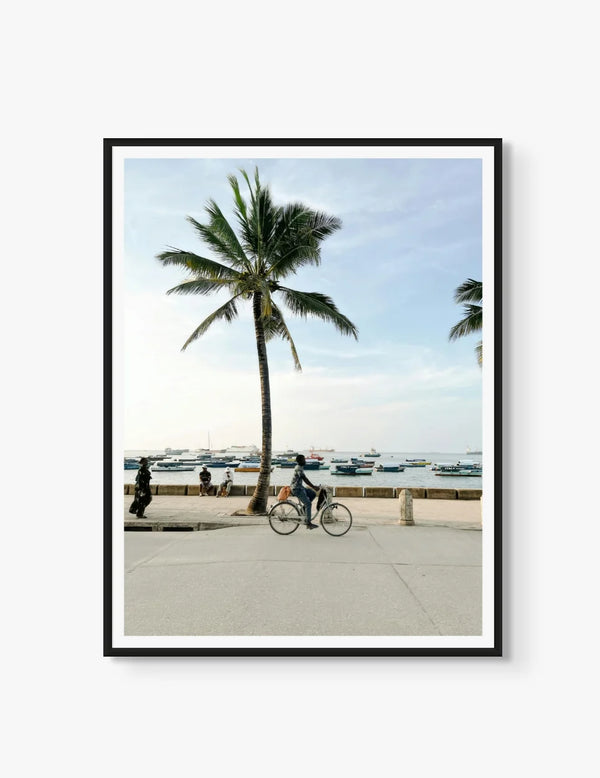Zanzibari Doors: Portals to Different Worlds

A picture is worth more than a thousand words, goes the saying. But in Zanzibar, it is a door that tells a thousand words. Sure, the beautiful beaches, welcoming people and the omnipresent heat are what most people know Zanzibar for. However, a quick stroll through the streets of Stone Town, Zanzibar (the older part of Zanzibar City, also known as Mji Mkongwe, Swahili for 'Old Town’) reveals an unmissable sight: the Zanzibari doors. The art form that marks the design of the Swahili door is as old as time, but reached its peak in quality and number in the 19th century, according to African Arts. What (else) makes this door so special?
Source: Britannica – Zanzibar
A Short History of the City That Makes the Zanzibari Doors
The Zanzibari door is most commonly found in Stone Town, Zanzibar. Inscribed by UNESCO as a World Heritage Site, Stone Town is the quintessential example of a Swahili coastal trading town in East Africa, as explained by the Stone Town Conservation and Development Authority. With its strategically beneficial location, Zanzibar’s port became a central hub for trade as early as the 1st century AD, connecting Africa with the Middle East, Asia and Europe, according to African Adventures. The port facilitated the exchange of goods such as spices, ivory, gold, and textiles, but unfortunately, it was also involved in the darker chapter of the transatlantic and Arab slave trades, with an estimated 1 million slaves passing through Zanzibar annually at the height of the trade. As a result, Stone Town developed into a melting pot of cultures, with influences from Africa, Arabia, India, and Europe shaping its architecture and society.
The town’s narrow, winding streets reflect its rich history, often so narrow that cars must carefully squeeze through, offering a glimpse of how Stone Town has maintained its authenticity. Among the most iconic features of this historic town are its doors. Zanzibari doors, with their intricate carvings and ornate detailing, are not only beautiful but are deeply rooted in cultural and social significance. They were considered a mark of social status and a declaration of one’s cultural and religious identity. The taller the door, the richer the detail, and the heavier the lock, the more affluent the owner was perceived to be – or, as is also said, ‘the greater is the owner’s dignity’, as noted in African Arts.
Estimated to number around 560, these doors are an integral part of Stone Town’s architectural identity, as highlighted in African Arts. With African, Arab, Indian, and European elements woven together, the doors tell the story of a town that has remained largely unchanged since its construction. Today, they stand as a reminder of Zanzibar's diverse heritage and as symbols of the island’s complex history. Each door offers a window into the past, reflecting not just the craftsmanship of the time but also the stories of those who once passed through them.
Zanzibari doors are characterised by a consistent design, built around seven key elements. The structure consists of two sturdy vertical side posts topped with a solid lintel. The door features two panels, with a thick vertical centre post connecting to one panel, ensuring the door closes securely. When shut, the centre post spans from the threshold to the lintel. The threshold itself is a robust beam positioned at the base of the door, typically raised 15-20 centimetres above the floor, as detailed in African Arts. From this consistent design, the following kinds of Zanzibari doors originate:
Swahili doors
The most modest and first of its kind is the Swahili door: Swahili doors are the epitome of craftsmanship and artistry, representing a rich cultural heritage along the Swahili Coast that stretches from Somalia to Mozambique. These doors are typically large and imposing, designed not only for functional purposes but also to serve as symbolic statements of status and wealth. The tradition of Swahili door carving can be traced back to ancient times, with significant developments during the 19th century in Zanzibar, a thriving centre for trade and culture. These doors are most often made from dense, durable woods like Mbamba kofi, known for their fine grain and precision in carving. They feature intricate designs that blend geometric patterns and natural motifs, such as lotus flowers, rosettes (symbolising reproductive power, and the number of family members living in the home), and fish (symbolising fertility), as noted by Focus East Africa Tours. The doors themselves, often adorned with large brass or iron bosses, serve as a gateway to the stories and histories of the men who commissioned them. Historically, these elaborate doors were some of the first elements constructed in a home, symbolising both wealth and the protection of the residence from time and intruders.
Arabic doors
The Arabic Zanzibari doors are entwined with the history of Zanzibar under the rule of the Omani Sultanate. The Arab influence on Zanzibar is not merely aesthetic but deeply rooted in the island’s cultural, political, and economic evolution. By the early 1800s, Zanzibar had become a key part of the Omani empire, with its strategic location in the Indian Ocean bolstering its significance in trade, particularly in slaves and spices. Sultan Sayyid Said bin Sultan of Oman, it is said, preferred the tropical allure of Zanzibar to his homeland, and in doing so, made it the capital of his empire in the 1840s. The architecture of the Arabic doors reflects the grandeur of this period, with intricate carvings, ornate designs, and the use of Arabic inscriptions (commonly citations from the Quran) often found on the lintels. These elements were not only decorative but also served as marks of prestige and ownership, showcasing the wealth and sophistication of their owners. The doors' massive size and elaborate embellishments were a means for the elite to assert their status in a bustling trade city where grandeur and power were reflected in the very entryways to their homes. Like commissioners of Swahili doors, Zanzibari Arabs also typically ordered carved door frames before beginning the construction of a house, ensuring that the frame was in place before the rest of the structure was built around it, as described in this 1924 article from the Man journal.
Indianised doors
Indian influenced Zanzibari doors were also called Gujarati doors. One type could be recognised by small, square shutters lodged into the door; another type of Indian door could be recognised by heavy brass studs and an arched top frame. These metal studs were originally meant to deter war elephants—a practical feature in the Indian subcontinent. Yet in Zanzibar, where elephants don’t roam, they serve as a testament to the cultural migration of ideas, designs, and traditions. The influence of Indian craftsmen, especially during the 19th century, is evident in the intricacy of the carvings and the materials used. Crafted from Burmese teak wood, these doors are a mark of opulence. In the past, wealthy Gujarati merchants imported this prized wood from Myanmar to Zanzibar.
Zanzibari doors are more than mere entryways; they are cultural artefacts that tell stories of trade, migration, and artistry. Their intricate designs reflect the diverse influences that have shaped Zanzibar's history—from the Swahili Coast to India, Arabia, and beyond. If these timeless doors have captivated your imagination, why not bring a piece of Zanzibari craftsmanship into your own space? Discover stunning art inspired by Zanzibar’s iconic environment, created by talented local artist Qarim Zam. Explore the collection [here] and let these historic designs find a place in your space.
YOUR NEXT READ
5 Tips for Finding the Best Framed Wall Art for Your Living Room


